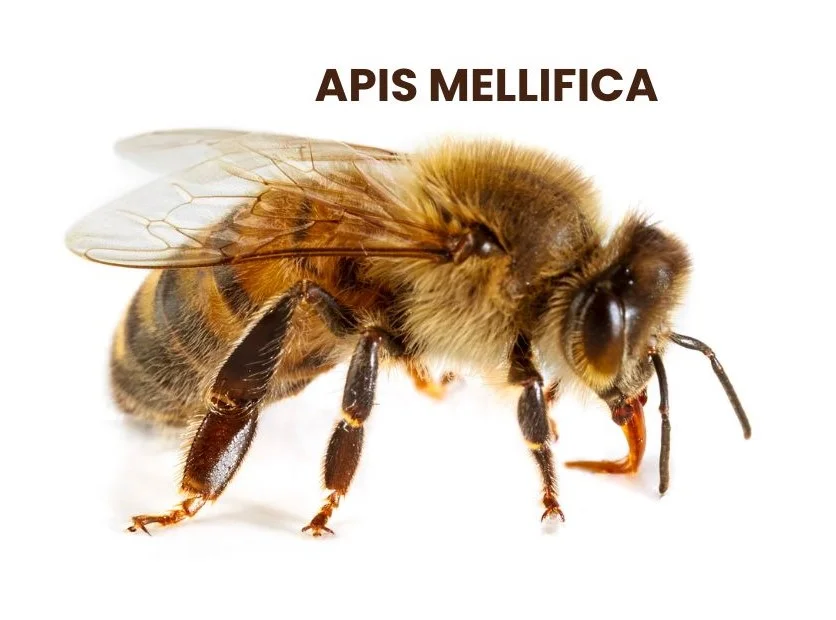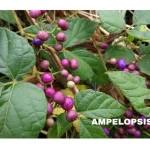Apis Mellifica, commonly known as Apis, is a valuable anti-Psoric homeopathic medicine derived from the poison of the Honey Bee.
The effects of a bee sting, such as burning, stinging pain, soreness, a red rose hue, and puffiness of the affected area sensitive to touch, are mirrored in the symptoms for which Apis is prescribed.
Individuals experiencing Apis-related conditions often exhibit irritability, restlessness, and may cry or weep until the pain subsides.
When Apis is proven on a healthy individual, it elicits similar pathogenetic symptoms, contributing to its clinical application in various health conditions.
SOURCE: Poison of Honey Bee
PROVER – BRAUNS

Table of Contents
ToggleSOURCE INFORMATION
- Kingdom: Animalia
- Phylum: Arthropoda
- Class: Insecta
- Order: Hymenoptera
- Family: Apidae
- Genus: Apis
- Species: mellifera
Origin: The Honey Bee (Apis mellifera) is native to Europe, Asia, and Africa. However, due to human cultivation for honey production, it has been introduced and established in various parts of the world.
Apis mellifera has a rich history, closely intertwined with human civilization. The practice of beekeeping, known as apiculture, dates to ancient times.
Historical records show that Egyptians practiced beekeeping around 2400 BCE, and ancient Greeks and Romans valued honey for its medicinal properties.
HERE IS AN INTERESTING POST ON HISTORY OF MEDICINE.
Bees and their intricate hives have been revered and studied for centuries.
The concept of the “honey bee dance” as a means of communication within the hive was discovered and documented by Karl von Frisch, a Nobel laureate, in the 20th century.
The medicinal use of Apis mellifica, or the poison of the honey bee, in homeopathy has been developed over the years.
Homeopathic preparations utilize the venom obtained from live honey bees, and the remedy is known for its effectiveness in addressing various health conditions.
CLINICAL USES
Apis is employed in treating a wide range of clinical conditions, including but not limited to abscesses, apoplexy, asthma, Bright’s disease, carbuncles, constipation, cancerous affections, diarrhea, dropsy, eye troubles, gangrene, hydrocephalus, intermittent fever, kidney affections, meningitis, menstrual troubles, rheumatism, skin disorders, tumors, urinary troubles, and more.
SPHERES OF ACTION
Apis demonstrates its therapeutic effects on cellular tissues, glands, skin, brain, urinary system, heart, pleurae, and serous membranes.
PATHOGENESIS
Apis is primarily characterized as a right-sided medicine with a profound impact on various physiological processes.
- Oedema of Skin and Mucous Membranes: Apis induces swelling or oedema in the skin and mucous membranes.
This is expressed as puffiness, redness, and a burning or stinging pain, akin to the symptoms observed in response to a bee sting.
- Kidney Inflammation and Oedema (Anasarca): The influence of Apis extends to the kidneys, provoking inflammation and subsequent edema.
In severe cases, it may lead to anasarca, a generalized swelling of the entire body due to the accumulation of fluid in the interstitial spaces.
- Hydrocephalus (Brain Inflammation): Acting on the membranes of the brain, Apis can induce inflammation, resulting in hydrocephalus.
This condition involves an abnormal accumulation of cerebrospinal fluid in the brain cavities, leading to increased intracranial pressure.
- Pleurisy with Effusion: Apis affects the pleura, causing pleurisy, an inflammation of the membrane surrounding the lungs and lining the chest cavity.
This inflammation may lead to the accumulation of excess fluid, known as pleural effusion.
- Synovitis (Joint Inflammation): The serous membrane of joints is susceptible to Apis’s influence, leading to synovitis.
This inflammatory condition affects the synovial membrane, resulting in joint pain, swelling, and stiffness.
- Glandular Enlargement and Induration: Apis has an affinity for glands, causing enlargement and induration.
This implies an abnormal increase in the size and hardening of glands, often associated with inflammation or other pathological processes.
DOCTRINE OF SIGNATURE OF APIS MELLIFICA
The Doctrine of Signatures suggests that plants and substances bear a resemblance to the ailments they can heal or treat.
In the case of Apis mellifica, or the honeybee, its signature characteristics offer insights into its medicinal properties:
Bee Sting: Apis mellifica is derived from the venom of the honeybee, which is known for its potent sting.
This signature characteristic suggests its potential to treat conditions characterized by stinging, burning pains, inflammation, and swelling.
Hive Structure: Bees construct intricate hive structures with hexagonal cells.
This geometric pattern may symbolize order and organization, hinting at Apis mellifica’s potential to address conditions related to fluid retention and inflammation, restoring balance and harmony within the body.
Honey Production: Honey, a product of bees, is known for its antibacterial, antifungal, and soothing properties.
While Apis mellifica is not directly related to honey production, its association with bees and their products may suggest its potential to alleviate symptoms of inflammation, itching, and irritation, similar to the soothing effects of honey.
Busy and Industrious Nature: Bees are known for their industrious and diligent work ethic.
This characteristic may symbolize Apis mellifica’s potential to address symptoms related to restlessness, agitation, and irritability, as well as its ability to provide relief from symptoms associated with allergic reactions or insect bites.
CONSTITUTION
- Make-up of the Body: Strumous constitution with a characteristic bag-like swelling under the lower eyelids, a pale, waxy, and oedematous face.
- Temperament: Apis is associated with an irritable temperament.
- Relation with Heat and Cold: Apis tends to be a hot patient.
- Miasm: Psora is in the background.
- Diathesis: Scrofulous diathesis.
WHAT IS CONSTITUTION IN HOMOEOPATHY?
WHAT ARE TEMPERAMENTS IN HOMOEOPATHY?
WHAT IS DIATHESIS IN HOMOEOPATHY?
CHIEF GUIDING SYMPTOMS
- Right-Sided Medicine: Apis predominantly affects the right side of the body, with symptoms often progressing from right to left.
- Aversion to Tight Bandage: Like Lachesis, Apis exhibits aversion to tight bandages.
- Pain Character: Apis is a potent pain remedy with a distinctive character of burning, stinging, and soreness. Pain suddenly migrates from one part to another.
- Thirstlessness: Generally, Apis is thirstless, except during the chill stage of intermittent fever. Thirstlessness is particularly notable in cases of dropsy.
- Extreme Sensitivity to Touch: The patient is extremely sensitive to touch, akin to other remedies such as Belladonna, Hepar Sulphur, Lachesis, and China.
- Oedema (Swelling) and Skin Conditions: Apis induces oedema, both general and local. A distinctive feature is a bag-like puffy swelling under the eyes. The skin alternates between dry and perspiring.
- Sensation of Suffocation: The patient feels suffocated, as if each breath could be the last. This is especially prominent in cases of dropsy and the heat stage of intermittent fever.
- Craving for Cold: There is a strong craving for cold substances, including cold milk and sour things.
- Involuntary Diarrhea: Apis can cause involuntary diarrhea with a sensation as if the anus is wide open, resembling other remedies like Secale Cornutum and Phosphorus.
- Urinary Symptoms: Urine is scanty, frequent, and painful, accompanied by sudden urging and strangury. There is a scalding sensation during urination, causing burning pain.
- Mental Symptoms: The mental state of Apis patients includes awkwardness, irritability, nervousness, fidgetiness, and a weeping disposition. The patient may cry easily, feel discouraged, and exhibit signs of despondency.
- Stupor and Shrill Screams: Stupor is accompanied by sharp, sudden, shrill screams, particularly in brain diseases. Delirium may occur after the suppression of scarlet fever eruptions.
- Ailments From: Various mental states, such as jealousy, fright, rage, vexation, and exposure to bad news, can trigger ailments. Apis is also indicated in cases where acute exanthemata (skin rashes) are imperfectly developed or suppressed.
- Sleeping Conditions: The patient may exhibit disturbed sleeping patterns, including a stuporous condition, twitching of one side of the body, and restlessness. The child may lie with the eyes partly closed, pupils contracted or dilated, and may kick off coverings, worsened by the heat of the room.
PARTICULARS
MENTAL SYMPTOMS
Apathy, Indifference, and Unconsciousness: Patients exhibit a lack of interest, emotional detachment, and may even lose consciousness.
Awkwardness and Clumsiness: They often display clumsiness, frequently dropping objects or behaving awkwardly.
Stupor and Sudden Cries: There are periods of mental stupor, interrupted by sudden, sharp cries or startings.
Erotic Mania Alternating with Stupor: They may experience alternating phases of mental stupor and periods of heightened sexual excitement.
Sensation of Dying: Patients may feel as if they are dying, contributing to their overall sense of listlessness and confusion.
Difficulty in Thinking Clearly: Clear thinking becomes challenging, leading to confusion and inability to concentrate, especially during attempts to read or study.
Irritability and Nervousness: There is marked irritability and nervousness, accompanied by fidgetiness and a tendency to be hard to please.
Sudden Shrill Screams and Whining: They may emit sudden, piercing screams or engage in whining behavior, particularly during episodes of brain disease.
Tearfulness and Emotional Vulnerability: The patient exhibits tearfulness and emotional vulnerability, often crying easily and feeling discouraged and despondent.
Triggers for Mental Aggravation: Mental symptoms worsen in warm environments or rooms, whereas cold weather provides some relief.
HEAD
- Apis Mellifica is highly effective for conditions like meningitis and hydrocephalus.
- Characterized by sudden, shrill piercing screams, especially in children during wakefulness.
EYES
Bag-like Swelling Under Lower Eyelids
- Distinctive puffiness under the lower eyelids resembling a bag.
- Lids appear red and swollen.
- Accompanied by a sensation of burning and stinging pain.
Lachrymation (Tearing)
- Tearing of the eyes with the tears being hot in nature.
Conjunctiva Inflammation
- Bright red and puffy conjunctiva.
- Serous exudation, leading to swelling and sharp pains.
Photophobia
- Intense sensitivity to light.
- Inability to tolerate or look at light.
Keratitis
- Inflammation of the cornea.
- Intense chemosis of the ocular conjunctiva.
- Chemosis refers to swelling of the conjunctiva.
Staphyloma of Cornea
- Formation of a staphyloma (a bulging or protrusion) on the cornea.
- Often follows suppurative (pus-forming) inflammation.
Prevention of Styes Recurrence
- Apis is beneficial in preventing the recurrence of styes, which are painful swellings on the edge of the eyelid.
GASTRO-INTESTINAL SYMPTOMS
Tongue
- The tongue in Apis Mellifica is characterized by its fiery red color, resembling other remedies like Crotalus horridus, Ferrum metallicum, and Pyrogenium.
- The tongue is swollen, sore, and raw, often presenting with vesicles.
- Sensation of the tongue feeling scalded, with a red, wet, and trembling appearance.
- In cases of cancer affecting the tongue, Apis may be indicated.
Stomach
- Thirstlessness is a notable characteristic, distinguishing it from many other conditions.
- The stomach feels sore, and there is a specific craving for cold milk, akin to the symptomatology of Rhus toxicodendron.
Abdomen
- Apis is indicated in conditions like ascites without thirst and peritonitis.
- The abdomen is tender and highly sensitive to touch.
DIARRHEA
- Common causations for diarrhea with Apis include cases involving drunkards and eruptive diseases, especially if the eruption has been suppressed.
- Stool characteristics include being watery, greenish, yellowish, slimy, containing mucus or bloody mucus, offensive, and painless.
- Involuntary stool with every motion, as if the anus is wide open, like Phosphorus and Secale cornutum.
- Constant oozing from the anus, often occurring unconsciously and without the patient’s awareness.
Before Stool
- Rumbling of flatus and sudden darting pain in the rectum may precede stool.
- Urging is present.
During Stool
- Griping tenesmus, rawness, and soreness in the anus accompanied by the passage of much flatus.
- Frequent painful urination, nausea, vomiting, backache, and frontal headache may be experienced during stool.
After Stool
- Rawness in the anus, heat, and throbbing in the rectum, with a sensation as if plugged.
- Tenesmus with the passage of blood, leading to a state of faintness and exhaustion.
Concomitants
- The patient typically experiences no appetite and little or no thirst.
- The tongue appears shining, dry, red, cracked, and sore.
- Abdominal walls feel bruised and sore with excessive tenderness.
- Urination is frequent, scanty, or suppressed, often accompanied by strangury (painful, frequent urination).
URINARY SYSTEM
In Apis Mellifica, incontinence of urine is noted, accompanied by significant irritation of the urinary organs.
There is a tendency for frequent and painful urination, and the patient can hardly retain urine for even a short period.
Urine is often scanty, being released only in drops.
Characteristics of the urine include being bloody, foetid (foul-smelling), and albuminous with casts (indicating kidney involvement).
The urine may appear very dark and frothy.
Before Urination
- The urge to urinate is constant and ineffectual, often arising as soon as a few drops collect in the bladder.
- There is much straining before urine starts flowing.
During Urination
- Severe scalding sensation and stinging pain are experienced during urination.
- Strangury, a condition involving painful, frequent urination with straining, is present.
- The last drop of urine burns and smarts, indicating irritation and inflammation in the urinary tract.
CHEST
- Apis Mellifica presents symptoms related to the chest, including hoarseness, dyspnea (difficulty breathing), and hurried, difficult breathing.
- There is a notable oedema of the larynx, giving the feeling as if the person cannot draw another breath. This sensation leads to suffocation and a short cough.
FEMALE GENITAL ORGANS
In the female genital organs, Apis Mellifica exhibits edema of the labia, which is relieved by cold water.
Oophoritis (inflammation of the ovaries) is accompanied by burning and stinging pain, particularly worse in the right ovary.
Ovarian tumor and metritis (inflammation of the uterus) with stinging pains are mentioned.
There is great tenderness over the abdomen and uterine region.
Menstrual Symptoms
- Menstrual symptoms include suppressed menses with cerebral and head symptoms, especially in young girls.
- Profuse metrorrhagia (uterine bleeding outside of menstruation) occurs with a heavy abdomen, faintness, and stinging pain.
- There is a sense of tightness and a bearing-down sensation, as if menses were about to appear.
Dysmenorrhea
- For dysmenorrhea (painful menstruation) with severe ovarian pain, Apis is considered a beneficial medicine.
Oedema of Labia
- In the female, oedema of the labia occurs, and this condition is alleviated by cold water.
- Soreness and stinging pains, particularly in the right ovary, are noted.
SKIN
The skin under the influence of Apis Mellifica appears waxy, pale, and swollen (oedematous).
It is highly sensitive to touch.
In cases of erysipelas (a bacterial skin infection), there is a sensation of stinging, burning pain.
Edema affects the face, particularly the lower eyelids, extending from right to left.
Urticaria
Urticaria, characterized by raised white wheals on the body, resembles bee stings or bites from other poisonous insects.
The skin experiences stinging, burning, pricking, smarting, or itching sensations.
- Aggravation: Symptoms worsen at night, with the application of heat, or in a warm room.
- Amelioration: Relief is experienced in cold temperatures and open air.
Boils and Carbuncles
Affected areas develop a rosy hue and become swollen and sensitive to touch.
Symptoms worsen with heat and covering, while cold applications provide relief.
Cancerous Affections
In cases of cancer, there is intense burning and stinging pain in the affected area, accompanied by extreme sensitivity to touch and overall soreness.
Cancerous metastasis affects the cellular tissue, leading to effusion.
- Aggravation: Symptoms worsen with warmth and hot applications, as well as with covering.
- Amelioration: Relief is obtained with cold applications.
FEVER
Intermittent Fever
- The onset of chill occurs at 3 p.m., accompanied by thirst (similar to Ignatia).
- Pulse is characterized by full and rapid beats, occasionally small and trembling.
- Chilliness is aggravated by the slightest movement.
- Swelling and burning of the lips persist throughout the entire paroxysm.
- Deep sleep follows after fever paroxysms.
- Nettle-rash may appear after perspiration, accompanied by shuddering.
- Thirst is absent during the sweating stage.
- Aggravation occurs in warm and heated rooms, as well as in response to external heat.
Remittent Fever
- Apis is a reliable remedy for remittent fever, particularly in cases where the fever takes on a typhoid form, or presents symptoms of meningitis or cerebral fever.
- Thirst is generally absent except during the chill.
- Chill runs along the back.
- Fever persists continuously and is of a low type.
- The patient dislikes being covered or touched due to heightened sensitivity.
- There is a constant preference for open air, uncovering, and cold drinks.
GENERAL MODALITIES
Aggravation
- After sleep (comparable to Lachesis).
- In closed, warm, and heated rooms.
- From getting wet (similar to Rhus tox.).
- Touch and pressure exacerbate symptoms.
- Late in the afternoon, particularly around 3 p.m.
- Symptoms are often worse on the right side.
- Aggravation in any form of heat.
Amelioration
- Relief is experienced in open air.
- Uncovering provides comfort.
- Cold bathing is soothing.
- Pains worsened by coughing, walking, or changing position.
- Improvement is noted when sitting erect.
WHAT IS AGGRAVATION AND AMELORATION IN HOMOEOPATY?
REMEDY RELATIONSHIP
Complementary: Natrum muriaticum (Nat. mur.): Apis complements Natrum mur. in chronic cases, especially when lymphatic involvement is present.
Follows well after: Arsenicum and Pulsatilla.
Inimical: Rhus toxicodendron (Rhus tox.) in eruptive diseases.
Antidotes: Cantharides, China, Iodum, and Digitalis.
DOSE
Forms: Tincture to thirtieth potency.
Specific Conditions: In oedematous conditions, lower potencies are often preferred.
Administration: The remedy might have a slow onset, and several days could pass before noticeable effects occur. In such cases, an increase in urine production may indicate the remedy’s action.
Complementary Remedy for Specific Cases: Apium virus in the sixth trituration may be considered.













Leave a Reply